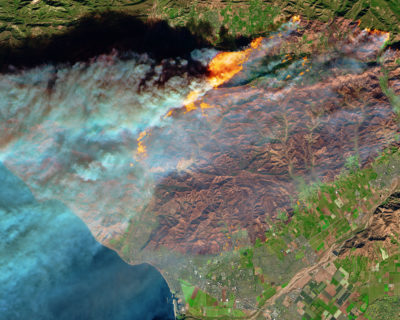The Thomas Fire in Ventura County, California as seen from space on December 5. Joshua Stevens/NASA Earth Observatory
The Thomas Fire burning north of Los Angeles in Ventura County, California is now the state’s fifth-largest wildfire on record. Less than 15 percent contained and moving west quickly, the fire is being fueled by dry conditions and strong winds. It is one of five wildfires currently burning in southern California.
The Thomas Fire grew by 50,000 acres over the weekend and now stretches more than 230,500 acres. It has destroyed nearly 800 structures and threatens another 18,000. Tens of thousands of people have been evacuated from the region. The five southern California fires are collectively burning an area larger than New York City and Boston combined. In total, 2017 has been the deadliest and most destructive year for wildfires on record in California, according to the state’s fire agency, Cal Fire.
After visiting areas destroyed by the Thomas Fire over the weekend, California Governor Jerry Brown said the current situation is the state’s “new normal” due to climate change. “This could be something that happens every year or every few years,” he said.
Fourteen of California’s 20 largest wildfires have occurred since 2000, “reflecting in part the growing influence of global warming,” reports Climate Signals, a scientific project that tracks the influence of climate change on current natural disasters. The state experienced its worst heat wave on record in September, and increasingly warmer temperatures in the last two decades have helped dry out the landscape, worsen drought conditions, and extend the length of the wildfire season.
“Research indicates a direct casual link between human-induced climate change and increased wildfire risk in California,” Climate Signals says. “Climate Change has contributed to California’s longer fire seasons, the growing number and destructiveness of fires, and the increasing area of land consumed.”
For more information on the link between climate change and worsening wildfires, click here.



